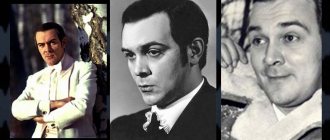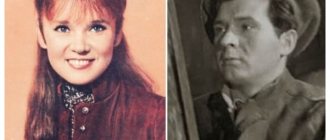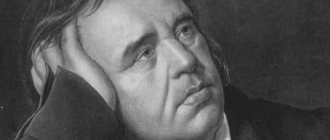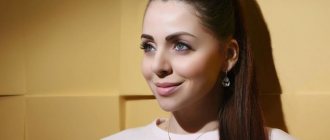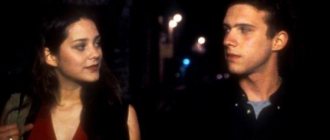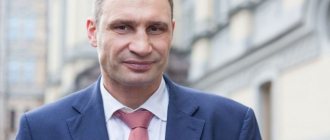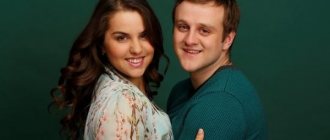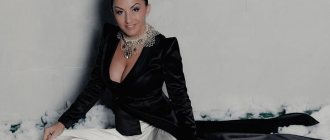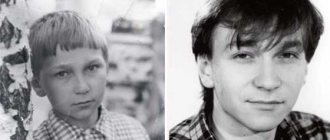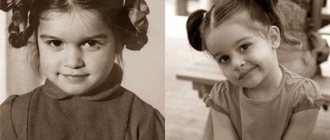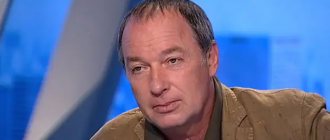Nikita Sergeevich Khrushchev was one of the most controversial leaders at the helm of power in the Soviet Union. The years of his reign are assessed both positively and negatively. “The Khrushchev Thaw” is the definition of 1953-1964. of the last century can be found in historical chronicles describing the reforms and political activities of Khrushchev. Although this “thaw” did not affect all spheres of life of the Soviet people, in many ways the situation only worsened. To this day, historians discuss and argue about his failures and victories. ...
short biography
Biography of N.S. Khrushchev's life begins on April 15, 1894, when he appeared in a miner's family living in the village of Kalinovka, Kursk province. The family barely made ends meet, and little Nikita had to work since childhood in order to somehow help his parents. There was time to study only in the winter. Before starting his political career, Khrushchev had the opportunity to work as a shepherd, mechanic, and miner.
It’s interesting to know: how the USSR differs from the RSFSR - definition of terms, their differences.
In 1918 he joined the ranks of the Communist Party. He took part in the Civil War under the banner of the Red Army. From this time his path in politics to the Chairman of the CPSU Central Committee began:
- 1920 - political director of a mine in Donbass;
- 1922 - party secretary of the Dontechnikum;
- 1925 - party leader of the Petrovo-Maryinsky district;
- 1927 - a fateful acquaintance with the “gray eminence of Stalin” Kaganovich, who drew attention to the young and ambitious man and saw him as a promising politician;
- 1928 - promotion to the central apparatus of the Communist Party of the Ukrainian SSR;
- 1929 - admission to the Industrial Academy of Moscow and the beginning of a rapid party career, secretary of the party committee of the educational institution;
- 1934 - First Secretary of the Moscow City Committee of the All-Union Communist Party (Bolsheviks);
- 1934 - Second Secretary of the Moscow Regional Committee of the All-Union Communist Party (Bolsheviks);
- 1935-1938 - First Secretary of the Moscow Regional Committee of the All-Union Communist Party (Bolsheviks);
- 1938 - First Secretary of the Communist Party of the Ukrainian SSR;
- 1941-1943 - member of military councils of several fronts, leads the partisan movement behind the front line, political commissar;
- 1944-1947 - Chairman of the Council of People's Commissars (Council of Ministers) of the Ukrainian SSR;
- 1949 - return to Moscow as the first secretary of the Moscow Committee and the Moscow City Committee of the CPSU Central Committee;
- 1953-1964 - years of rule in the USSR (First Secretary of the CPSU Central Committee, from 1958 - Chairman of the Council of Ministers of the USSR);
- 1964 - removal and resignation from office.
He was married twice (according to unofficial data - three times). The marriage with his second wife Nina Petrovna Kukharchuk was officially registered only in 1965, although their life together began in 1924.
This is interesting: The Russian Civil War of 1917-1922, a table with a brief overview.
Awarded:
- Hero of the Soviet Union;
- three times Hero of Socialist Labor;
- Order of Lenin;
- Order of the Red Banner of Labor;
- Order of Suvorov I and II degrees;
- medals.
Died on September 11, 1971. He was buried at the Novodevichy cemetery.
This is interesting: what contributed to the unification of the Arab tribes in the Middle Ages?
Legend of Kalinovka
This week marks the 120th anniversary of the birth of Nikita Khrushchev. The figure of the former leader of the country still causes fierce controversy. The father of the Thaw and a participant in repressions, a gravedigger of the cult of personality and a persecutor of the church - why is he interesting to us today? What bright future Nikita Khrushchev dreamed of, “Ogonyok” found out after visiting the homeland of the first secretary. And from this very future, with the help of grateful contemporaries and descendants, he appreciated his contribution
Text: Nikita Aronov. Photo: Oleg Nikishin
The M3 Ukraine highway, closer to the Ukrainian border, behaves strangely. First it goes south, enters about 10 kilometers into the Kursk region and there it makes a sharp turn to the west. All this is surprising if you don’t know one simple fact: Nikita Khrushchev first of all built a highway to his native village of Kalinovka, Khomutovsky district, Kursk region, and only then to Kyiv.
Kalinovka is a place where Khrushchev is treated exclusively with a plus sign. This is a kind of showcase of Khrushchev's rule. Here the corn grew three meters high, and Khrushchev houses were built, and the collective farmers’ salaries were the envy of everyone. Here they know exactly what kind of future Nikita Sergeevich dreamed of for the country.
The state farm canteen has been empty for a long time
Photo: Oleg Nikishin, Kommersant
They had a great era
In the middle of the last century in Kalinovka there were only flimsy huts with thatched roofs and a run-down collective farm. Now half the village is occupied by majestic reminders of Khrushchev’s civilization.
“Nikita Sergeevich built a lot in Kalinovka, and much of it is now abandoned,” states school history teacher Vladimir Khudyakov, a short and stocky man in his early 30s. He is in charge of the school museum and is considered the main expert on Khrushchev among the young people. “We visited two canteens: for the technical school and for residents, there was a multi-story hotel, a bus station, but now there is nothing.
In the center of the village, around the monument to Lenin, there are complete ruins. From the long building, which combined a hotel, a supermarket and a college canteen, only the first floor and a lonely window on the second remained. The peasant canteen, a pinkish building with a gable roof, has been standing for a long time with broken glass. The first floor of the state farm office is occupied by shops. The former bus station is also given over to retail. But in memory of Khrushchev’s times, the end point of bus routes from Kursk is still not the regional center of Khomutovka, but small Kalinovka.
Another symbolic Khrushchev brainchild is the agricultural technical school. In general, there cannot be a technical school in a small locality. But in Russia, if exceptions to the rules occur, it is only with permission from above. So the Kursk regional technical school moved to Kalinovka. Even Khrushchev’s resignation did not stop the construction of dormitories and workshops. So the technical school is a kind of farewell greeting to the famous fellow countryman.
The fountain in front of the technical school's porch is not working now, but its concrete sheaves and ears of corn shine with fresh yellow paint. Inside the building there are faded stands, few students, desolation.
“Previously, there were 1,300 full-time students,” recalls director Vladimir Koptsev. “And there are about the same number of part-time students.”
This, by the way, is more than the entire current population of Kalinovka. Now there are about 300 students in all departments of the technical school. Of the two five-story dormitories, only two floors of the first building are used. The second one is gradually turning into more ruins.
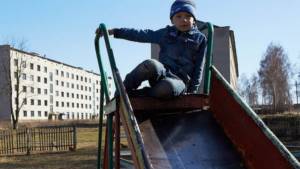
Through the efforts of Nikita Sergeevich, part of the village acquired a completely urban look
Photo: Oleg Nikishin, Kommersant
Khrushchev and corn
Once, for the arrival of a dear fellow countryman, the boarding school equipped two guest rooms with the first water closet in Kalinovka. But the first secretary of the CPSU Central Committee dreamed that everyone would live with comfort, so water supply and sewerage soon appeared here. Naturally, there were also Khrushchev buildings - two brick four-story buildings went up on Komsomolskaya Street.
“He wanted to move the whole of Kalinovka into such houses so that we could live like a city.” But not a single household came here,” recalls former milkmaid and editorial writer Zoya Alyuskina.
They didn’t force anyone into Khrushchevkas, they left people a choice. In general, the famous experiments in Kalinovka proceeded surprisingly smoothly. Even the notorious socialization of cattle was balanced by a well-functioning milk distribution system.
“When the cows were taken away, everyone cried,” recalls Zoya Alyuskina. “But then they set up three booths where they started giving milk, and butter twice a month.” And people quickly calmed down.
As for the main talk of the town, corn, it is still held in high esteem in Kalinovka. Under the queen of fields there is more land here than in the days of the Khrushchev’s Motherland collective farm - about 3 thousand hectares. The collective farm is long gone, but even the meadow where Nikita Sergeevich tended cows as a boy has been plowed up for corn.
“Khrushchev was a very advanced man for his time,” says Vitaly Burukhin, the owner of the local Sapphire farm. “He looked at things correctly and did the right thing in promoting corn. Now, however, there has been a very large revolution in technology development and in terms of corn we are now very behind Europe and America, which was not the case under Khrushchev. At the same time, Russia still produces more than 10 million tons of corn grain and successfully exports it.
Burukhin is a local, a native of the neighboring village of Zhedenovka. When the Kalinovsky fields, having passed successively through a collective farm, a state farm and a combined state farm-technical school, came to him, almost the first thing the farmer did was restore corn crops - planting this crop in the Kursk region is really profitable: there is both grain and silage for a large dairy herd. Except that no one grows three-meter-long stems with abundant fertilizer anymore, because they are not trying for exhibitions, but for business.
Car of conscience
Khrushchev lived in Kalinovka only until he was 14 years old, when his family left for a mine in Yuzovka. Then, in 1917, Nikita Sergeevich returned to his small homeland for a short time and, according to the official biography, participated in the local committee of the poor. But there is no documentary evidence of this. The famous fellow countryman reminded himself of himself immediately after the war, when he sent horses and two Studebakers from Kyiv to help his native village. There were as many as 150 horses and 40 carts in addition, a great generosity for those times. And soon the leader of the Ukrainian Communist Party himself visited Kalinovka.
— In 1946, he was passing through from Ukraine. It was then that we all learned that Nikita Khrushchev was our fellow countryman. “The majority didn’t remember him,” says old tractor driver Vladimir Gorlov. “He found one friend, Philip Vasilyevich Slobodchikov, they once herded cattle together. Then, no matter how he arrives, he always takes this old shepherd with him.
Then Vladimir was still a boy. Now his great-grandchildren are growing up, he has passed his eighties. But the grandfather still speaks low and booming, gesticulating with his hands with the “Vova” tattoo. In 1958, already a Komsomol member, he had the opportunity to sit with the first secretary at the same table.
Khrushchev then once again came to Kalinovka. In honor of this, they organized a rally, where Vladimir went along with his friend, the foreman of a tractor brigade. Then the distinguished guest was called to dine on the second floor, in the reading room of the library, and the people began to disperse.
“And we lingered in front of the club, we were already thinking about leaving, when lo and behold, Volodya, an agronomist, comes out and invites us in,” recalls Vladimir Gorlov. “There was only one person accompanying Nikita, wearing narrow medical uniforms with captain’s stars.” And there are about 14 of us collective farmers, or something. Nikita said: we won’t drink too much, just a little dry wine. And everything is laid out on the tables. Well, the foreman and I immediately drank a bottle of wine. Otherwise he will leave and everything will be lost.
After the official toasts, Khrushchev started talking about the economy.
“When he arrives in Kalinovka, he always goes down first and checks the fields,” explains the tractor driver. “That time he said that we don’t plant enough buckwheat.” And then they brought us a whole bowl of buckwheat with milk.
It seems that Nikita Sergeevich really liked this peasant dish, since buckwheat with milk also appears in the story about another Khrushchev visit - in honor of the opening of a kindergarten.
“The restaurant arrived from Kursk on several trucks,” recalls the elderly builder of this kindergarten from the Khomutov SMU, Mikhail Ryabykin. “Khrushchev himself was given lunch from thermoses.” But he only ate buckwheat porridge with milk. And he drank a little: 150 grams of vodka and 150 grams of cognac. He behaved like a village man. Straw hat, chrome boots.
Khrushchev willingly received fellow villagers at his place, first in Kyiv, then in Moscow. Milkmaid Zoya Alyuskina, for example, after a trip to VDNKh, was invited to the first secretary for tea.
“He called a young woman in an apron and said: bring them tea and refined sugar, one piece at a time, otherwise the Kalinovskys are used to drinking extra,” Zoya Matveevna smiles. “He was joking about how rich we are.”
Khrushchev behaved touchingly with his fellow villagers. And he helped and reprimanded, for example, about weeds in the field. Apparently, this is how he imagined the ideal relationship between power and the people. Here, perhaps, the following recollection of Zoya Alyuskina is indicative:
— When Nikita Sergeevich first came here, people asked him for salt. He says: I will send you a carload of salt and a carload of conscience.
However, he did send salt.
But after his resignation in 1964, Khrushchev never came to Kalinovka again. I probably didn’t want to spoil the image of a benefactor.
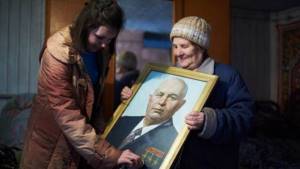
The ceremonial portrait of the first secretary is taken out from the cabinet only on his birthday, and for tourists, if asked
Photo: Oleg Nikishin, Kommersant
Currency collective farm
Of course, there was no way to expand Kalinov’s experience throughout the country. To understand how unique this case was, one fact is enough - the collective farm “Khrushchev’s Motherland” had its own foreign currency account.
On his next visit, Nikita Sergeevich promised to build a “mint” in the village. At first the collective farmers did not understand what they were talking about. It turned out that we were talking about a hemp plant. Vast areas around Kalinovka were sown with hemp, and the valuable raw material was exported. Foreign exchange earnings made it possible until the collapse of the USSR to successfully build and pay prohibitively high salaries for the village.
During the Brezhnev era, the leading decorated milkmaid Zoya Alyuskina earned almost as much as a Moscow engineer - 125 rubles a month. Ordinary workers had, of course, lower salaries. There was no end to those willing to work. In order to get a job on the Kalinovsky collective farm and the state farm that replaced it, some had to take a Komsomol permit.
Workers from all over the region traveled to the privileged village. And this continued for many years after the first secretary retired. As a result, the majority of residents of Kalinovka are now visitors who have never seen their famous fellow countryman alive.
— My grandfather, he died in 2007, he repeated more than once: who is left from Kalinovka here in Kalinovka? And indeed, our population is indigenous at most 10-15 percent,” states Vladimir Khudyakov.
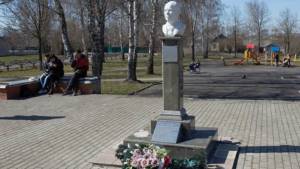
Fresh flowers will appear here on April 17, the birthday of the famous countryman
Photo: Oleg Nikishin, Kommersant
Anniversary
So, when 10 years ago the village administration invited fellow villagers to chip in for a bust of Khrushchev for the central park, there were only a few takers. The idea was saved by State Duma deputy from the Kursk region Alexey Volkov.
“He found out that in Moscow the Ministry of Culture kept a bust and a monument somewhere in the archives, and he helped us get this bust,” says the head of the settlement, Anatoly Puchkov.
So now the bust of Nikita Sergeevich stands in the park between the cultural center and the pond. Neighboring it are the concrete wolf from “Well, Just Wait!”, Pinocchio, a pair of lions and an obelisk in honor of the commissar who died during the German offensive.
There are also corners dedicated to the famous fellow countryman in the school museum and the technical school museum. Finally, there is a stele near the place where Khrushchev’s house once stood; the Kalinovites erected it themselves.
In honor of Nikita Sergeevich’s centenary, this part of the village was even named Khrushchev Street. And before the anniversary there was no name at all. One end of it was called Dolbilovka, the opposite - Romashkino.
Natalya Nikolaevna Khudyakova now lives on the site of the Khrushchev house, next to the stele. She respects Nikita Sergeevich very much: “He was a wonderful man. He told the whole truth and showed Kuzka’s mother to America.” She even has a ceremonial portrait of the first secretary with three Hero stars.
The portrait used to hang on the wall in the bedroom, but for the last two years it has been lying on the closet in the summer house in the backyard. They removed it during renovations and then left it that way. After all, this is an attribute of a calendar holiday, needed once a year. But on Khrushchev’s birthday, April 17, Natalya Nikolaevna always brings a portrait to the stele.
This year Khrushchev would have turned 120 years old, so a big celebration is planned with a rally in the park, a concert in the club and a round table “The role of Nikita Sergeevich in the history of the country” at the Kalinovskaya school. Festive rallies with concerts are organized here only for Khrushchev anniversaries. But every year, on the birthday of the famous Kalinov resident, a regional volleyball championship is held. “Because the time is like this: it’s warm for hockey, it’s cold for football,” explains Anatoly Puchkov. Border guards, police, schools, sports schools from all over the region are participating. Of course, the Kalinovites are winning more and more often.
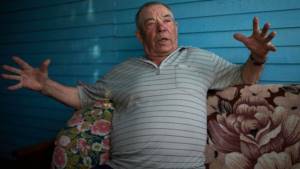
Tractor driver Vladimir Gorlov feasted with Khrushchev twice
Photo: Oleg Nikishin, Kommersant
Memory
In general, Khrushchev’s birthday in Kalinovka is something like a patronal holiday. Others include November 21, Michaelmas, a temple day in the new St. Michael the Archangel Church. The old Church of the Archangel Michael, where Nikita Sergeevich was baptized, was demolished during his reign and a club was built. And the old cemetery where Khrushchev’s first wife was buried was razed. But it was not possible to eliminate religion in Kalinovka. In 2000, the former hardware store was crowned with a dome and converted into a temple.
But fellow villagers have no complaints against Nikita Sergeevich for the old temple and cemetery. Even the Crimea donated to Ukraine by Nikita Sergeevich is easily forgiven here.
“He was an idealist, he believed in a bright future. And for him it didn’t matter where Crimea was: in the RSFSR or in Ukraine, Khrushchev did not imagine that the countries would ever be different, says teacher Khudyakov.
Some people look at things in a purely feminine way.
“He was handsome, chubby, good,” recalls Alexandra Ivanovna Kuleshova.
“If Nikita Sergeevich had stayed in power a little longer, Kalinovka would have become a city,” inserts Andrei, a lively man of about 50 in camouflage and rubber boots. “I saw old maps: yours, Aunt Shura, the house was supposed to be demolished, but here they were going to build a street . There was also a small winery built here. They just didn't launch it.
Alexandra Ivanovna looks at Andrey skeptically. She had never seen such old cards. And I haven’t heard anything about the winery.
It would seem that only half a century has passed, eyewitnesses are alive, but the debate about Khrushchev’s times does not stop here. How many times has a fellow countryman visited them? Six, seven or eight? Old people bicker until they are hoarse. And there are four versions regarding the number of floors of the collapsed hotel on the main square. The image of the real Nikita Sergeevich in Kalinovka is increasingly blurred, overgrown with legends and turns into a wonderful past. What can you do, he never led his homeland, small or large, into a bright future. But at least the past turned out to be glorious.
Rise to power
In March 1953, the leader of all times and peoples, Joseph Vissarionovich Stalin, passed away.
And while crowds from all corners of the vast country flocked to his coffin, a serious struggle began in the government for the vacant seat between N.S. Khrushchev and Lavrentiy Beria. With the support of G.M. Malenkov and Marshal of the Soviet Union Zhukov, Khrushchev initiated the removal of Beria from all posts, his arrest and subsequent execution. And already in the fall of September 7, 1953, Nikita Sergeevich Khrushchev was elected first secretary of the CPSU Central Committee and took the helm of the country’s power. This came as a surprise to many, since everyone was accustomed to considering him a simpleton who did not have his own opinion and blindly followed all Stalin’s orders and supported him in everything.
A series of successful and frankly stupid , sometimes curious, decisions and reforms began - this is how the years of Khrushchev’s rule can be briefly described.
Useful to know: who the Bolsheviks were, their role in the history of the USSR.
Domestic policy under Khrushchev
Khrushchev, whose reign began in 1953, did not leave any sphere of human activity without his attention - he was involved in politics, economics, and science. From his point of view, all reforms were aimed at improving people’s living standards and boosting the country’s economy:
- agrarian reforms;
- military reforms;
- social reforms;
- management reform.
Since 1954, by order of the leader of the country, active development of virgin lands began - the endless steppes and open spaces of Kazakhstan, Siberia, the Volga region, and the Southern Urals.
From all corners of the Union, young people responded to the call and went to build their lives in new territories. In 1955, the era of corn began in the country. After a meeting with the US President in Geneva, Khrushchev put forward one of his slogans: “Catch up and overtake America!” Impressed by stories about the unprecedented growth of corn in the United States, he decided to grow this crop throughout the Soviet Union, regardless of climatic conditions. The “Queen of the Fields” had to grow everywhere, even where it could not grow in principle. As a result, the corn procurement plan was disrupted and, because of this, the procurement of meat and dairy products was reduced.
One of the most significant events in Nikita Sergeevich’s political activity was his speech “On the Cult of Stalin’s Personality” at the 20th Congress of the CPSU in February 1956. This marked the beginning of the process of rehabilitation of victims of Stalin's repressions - thousands of political prisoners were released. This caused a wave of mass approval among the population - many of their loved ones, relatives and friends had suffered in previous years. The beginnings of freedom of speech appeared.
In 1957, during a speech at the next plenum of the Communist Party, Khrushchev made a proposal to stop payments to the population on bonds, which led to significant losses of savings among the population.
The leader's innovations in the country's economy did not bring results for its development, although the years of Khrushchev's rule were marked by an attempt to introduce elements of a market economy.
Since 1958, further decline in agriculture has continued. Beginning with the “age of corn ,” it continued by limiting the number of livestock that peasants were allowed to keep, and, as a result, the destruction of domestic animals.
At the same time, collective farms were actively enlarged and transformed into state farms. The peasants finally received passports and the opportunity to receive pensions. In 1957, the first attempt to remove Khrushchev from power was undertaken, which he managed to prevent with the support of Zhukov. All who openly opposed him (Malenkov, Molotov, Kaganovich and Shepilov) were dismissed, their places were taken by supporters of the leader. In 1958, he included the marshal loyal to him among them and also removed him from business. There have been changes in the ruling party - democratization, a change in the conditions for joining its members.
Another positive side to the decade of N.S.’s reign. Khrushchev's housing policy. The goal was to provide housing for as many people as possible. And the famous “Khrushchev buildings” appeared - apartment buildings with “cardboard” walls. People were happy about this too - their own small apartment is better than a room in a communal apartment.
The cultural life of the country flourished with the support of Khrushchev - censorship for writers was weakened, a film studio and television broadcasting began to operate. In 1961, the first youth congress was held in Moscow. And on the other hand, there is persecution of avant-garde artists due to a simple misunderstanding of their work.
A breakthrough was made in the space field - the launch of the first artificial satellite and the first flight into space by Yuri Gagarin.
Military reform brought the Soviet Union nuclear missile weapons and a strengthened defense industry. And at the same time - a reduction in the personnel of the armed forces, a weakening of the fleet by the destruction of large-tonnage ships for scrap.
Nikita Sergeevich did not ignore education either. The school reform was to introduce compulsory 8-year basic education. To obtain secondary education, it was possible to attend a secondary polytechnic school.
During the Khrushchev era, persecution and oppression of the church intensified.
Dissatisfaction in all layers of society with such management of the country grew exponentially. And everything positive and good that he did during his years in power was more than destroyed by his mistakes. Khrushchev's domestic policy failed.
Who is Nikita Khrushchev?
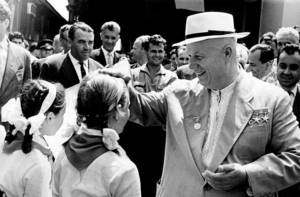
Nikita Khrushchev was a “master of words,” confident in his unconditional rightness. This characterization was given to the First Secretary of the CPSU Central Committee in 1961 by the Central Intelligence Agency (CIA) in a report, an excerpt from which was published by Slate on February 21. The 155-page document itself, recently posted on the John F. Kennedy Library website, was prepared for the American president on the eve of his meeting with Khrushchev in June 1961 in Vienna, at which the heads of state were to discuss the German question.
In addition to the dossier on the General Secretary of the CPSU Central Committee, the report included reference materials on negotiations between Khrushchev and President Dwight Eisenhower, as well as other materials on the history of diplomatic relations between the USSR and the USA.
“In his speeches he often refers to his simple origins. He is proud of his personal achievements and is confident that his abilities, determination and initiative are commensurate with his position; he is jealous of his privilege and is proud of his resourcefulness, which allowed him to bypass his rivals who underestimated him,” this is how the drafters of the document described Khrushchev.
The dossier on him says that after Stalin's death in 1953, Khrushchev was not such a prominent figure on the international stage, unlike Molotov, Malenkov, Beria and Mikoyan. But over time, he began to emerge from their shadow.
Initially, in the eyes of the West, Khrushchev created the impression of “an impulsive, limited, difficult person to communicate with, to some extent even a buffoon and a drunkard.”
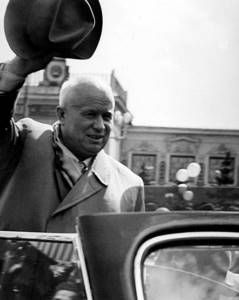
Nikita Khrushchev at the All-Union Agricultural Exhibition in Moscow, 1956. Reproduction of TASS photo chronicle
“As the “cult of Khrushchev” rapidly increased its influence, the Secretary General himself rose to a higher and higher hierarchical level and acquired new powers. Over the past two years, significant changes have taken place under him both within the Communist Party and in the government as a whole,” the document says. And after the first secretary established himself at the top of the Soviet hierarchy, “Khrushchev and his propagandists began to inflate his image into an international figure.”
At the end of the 1950s, the image of the Secretary General was adjusted: Khrushchev decides to abandon public manifestations of his addiction to alcohol; Thanks to the professionalism of his staff, he appears before the world community as a person endowed with a sharp and lively mind, eloquence and deep knowledge in various fields.
Representatives of the West, the dossier notes, when analyzing Khrushchev’s personality, were divided in their opinions regarding the motives of his actions. Some came to the conclusion that he was an absolute pragmatist and practitioner, following the Stalinist doctrine more out of habit than out of conviction. Others were struck by his dogmatism and noted the limitations of his horizons to the ideas of Marx, Lenin and Stalin.
“In fact, he could work with time-tested doctrines, even if they seemed outdated or irrelevant to him, as, for example, in the case of Lenin’s assertion that war was inevitable. And at the same time, he repeatedly repeated to the world community about the upcoming triumph of communism,” wrote US intelligence officials.
They described Khrushchev as a “master of words,” “an actor who plays vivid roles,” and a “psychological manipulator.” At the same time, he is credited with such qualities as a lack of insight and confidence in his unconditional rightness, sometimes not supported by any arguments: “It is because of this trait of his character that he seems devoted to communist ideology, when in reality he rather follows the principles of communist progress, where the end justifies the means, and adherence to communist doctrines itself grows more likely from blind faith than from their understanding.”
The meeting between John Kennedy and Nikita Khrushchev took place in Vienna on June 4, 1961. At it, the heads of state were supposed to determine the prospects for further relations between the USA and the USSR and discuss the resolution of issues related, in particular, to the civil war in Laos, the ban on nuclear weapons tests and the Berlin crisis, the beginning of which is considered to be Khrushchev’s ultimatum of November 27, 1958 (known as "Berlin ultimatum"). The negotiations failed, their result was the construction of the Berlin Wall in August 1961, which was demolished only at the end of 1989.
Foreign policy under Khrushchev
Historians date Khrushchev’s first mistakes as a leader to the period of his Ukrainian rule during the Great Patriotic War.
It was he who was responsible for a number of major failures and defeats on the territory of Ukraine during military operations. Having become the head of the USSR, his mistakes became more global. They explain this by his incompetence, short-sightedness as a politician and personal ambitions. Khrushchev's foreign policy is characterized by a large number of contrasts and contradictions. The report exposing Stalin’s policies worsened, or rather even nullified, relations with his closest ally, China. In Hungary, an attempt to overthrow the communist regime ended with the introduction of the USSR Armed Forces into its territory and the brutal suppression of the uprising.
At the same time, Khrushchev actively tried to establish contacts with the United States and Western countries. He understood perfectly well that the Cold War was dangerous and could lead to a new world war. In 1959, he was the first Soviet leader to travel to the United States and personally held talks with President Eisenhower there. And yet, it was Khrushchev who initiated the Berlin and Caribbean crises. The first resulted in the construction of the Berlin Wall in 1961. The second almost led to the start of a nuclear world war.
In 1954, the autonomous Crimean region was transferred to the Ukrainian SSR. Historians to this day have not found a logical explanation for this act. Either in this way he wanted to find support among the Ukrainian leadership, or he was trying to make amends for the mass repressions carried out during his reign there. But what this led to can be observed now.
[edit] Career
Since 1909, he has been a mechanic at factories and mines in Donbass. Since 1918, he participated in the civil war on the side of the Bolsheviks as a political worker. Since the early 1920s. held leadership positions in the Communist Party of Ukraine.
In 1924 he became a member of the Trotskyist opposition. L.M. Kaganovich, however, with Stalin's permission, promoted Khrushchev, since he renounced Trotsky and sincerely became a convinced Stalinist:
He was a Trotskyist. And I reported to Stalin that he was a Trotskyist. I spoke when they elected him to MK. Stalin asks: “What about now?” I say: “He is fighting the Trotskyists. Actively performs. He fights sincerely." Stalin then: “You will speak at the conference on behalf of the Central Committee, that the Central Committee trusts him.”
Since 1931 - in Moscow. In 1929-1930 Studied at the All-Union Industrial Academy (Moscow). It is known that he is the most uneducated of all the country's leaders in the foreseeable past, he read little and practically could not write. Since 1935, first secretary of the Moscow city and regional party committees. From 1938 to March 1947, Chairman of the Council of People's Commissars (since 1946, Council of Ministers) of the Ukrainian SSR. He was directly related to political repressions in Moscow and Ukraine. During the Great Patriotic War of 1941-1945. member of military councils of a number of fronts. Since 1949, Secretary of the Central Committee and First Secretary of the Moscow Committee of the All-Union Communist Party (Bolsheviks).
Khrushchev's resignation
A natural result of such domestic and foreign policies of N.S.
Khrushchev's resignation was the result of another conspiracy by his opponents, this time successful. In October 1964, the Chairman of the Council of Ministers of the USSR was resting calmly when, on the 14th, the Plenum of the CPSU Central Committee decided to resign from the post of Chairman, and a day later, to remove him from the post of head of state. This time there was no support from loyal comrades, just as it was not forthcoming from either the army or the KGB. Khrushchev's resignation took place quietly and calmly, without bloodshed or unrest. The head of state was Leonid Ilyich Brezhnev , who was at the head of the conspiracy.
The removal of Khrushchev caused wariness among Western leaders; it was unknown what to expect from the new Kremlin protege. But the fears were not justified and the “new” Stalin did not come.
Nikita Sergeevich himself lived out his life calmly, recorded his memoirs on a tape recorder and died of a heart attack on September 11, 1971. He became the first Soviet leader to resign alive.
